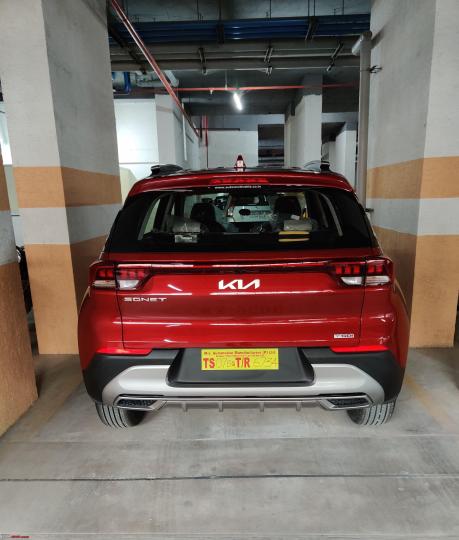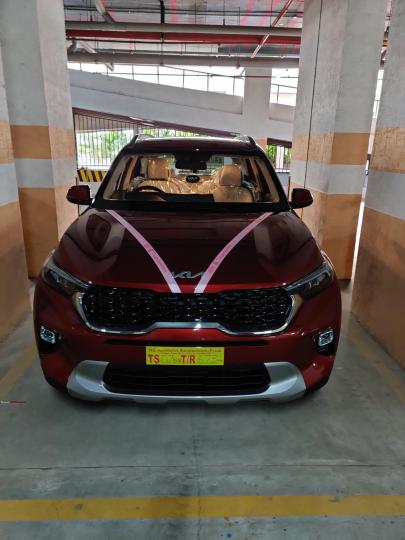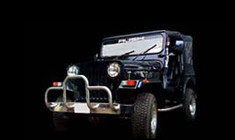News
My 2021 Kia Sonet: Buying & 5000 km ownership experience
We decided to replace our almost 10-year-old Hyundai i10 with a CSUV. We went ahead with the Sonet as it fulfilled our requirements.
BHPian Sandgrains28 recently shared this with other enthusiasts.
We have owned a 2021 Kia Sonet HTX Turbo 1.0 iMT for just over 6 months now and I thought of sharing our experience so far here. I have noticed that there are very few ownership posts for the Sonet on the forum.
We have driven around 5000 km in the car, including a 2200 km round trip, and a few other smaller trips. The driving experience has been great and the ownership experience has been relatively hassle-free so far. Please bear with me if this gets a little long-winded at times. Here goes.
Much-awaited Upgrade - Making the Choice
A brief background on how we settled on the Sonet when we decided to upgrade from our i10 Kappa 2 Sportz which had given us a more or less fuss-free experience for almost 10 years. We had decided on a CSUV rather than a sedan for the upgrade a while ago, the main reasons being us wanting a more commanding road presence and a better ride while also having a compact footprint in the city. When we began researching possible options, there were quite a few contenders in the CSUV segment but the missus and I really had a shortlist of only two – the Sonet and the Ford Ecosport.
Briefly, this is why the other options were eliminated:
Hyundai Venue
While we knew that mechanically it was the same as the Sonet, the missus was not at all a fan of its looks. The design felt a little outdated and the car looked more hatchback than SUV. Also, the variants were spread a little thin in comparison with the Sonet.
Tata Nexon & Mahindra XUV 300
Having owned an i10 for a long time, we were used to the amazing fit and finish, and the feature-richness of a Hyundai. The i10’s interiors, in fact, were a notch above several of the sedans which were its contemporaries. It was therefore important for us that the interiors of our new car be top-notch and that the feature list be able to stand the test of time. While the build and safety rating of the Nexon was a big draw, for us it simply didn’t have that finesse of the Koreans in the way it was put together. The XUV 300, while having a great engine plus reasonable interiors and some good features, had a tiny boot which would have caused us to compromise on some of the road trips we had in mind.
Renault Kiger & Nissan Magnite
While the spec list on both looked great, we felt they were underpowered in comparison to the competition. Also, we weren’t sure of how the ASS from Renault and Nissan would be.
So, accounting for all parameters such as a refined driving experience, feature list, quality of interiors and boot space, the final choice was to be between the Ecosport and the Sonet. The Ecosport was a pleasure to drive during the TDs and would have won hands-down if drivability was the only factor to be considered. However, the design felt dated and the sideways-opening tailgate was a big con considering the cramped parking conditions that we frequently encounter on our roads. At that point, we had also started hearing murmurs about Ford’s impending exit from India. As good a package as the Ecosport was, it felt like a gamble choosing it as our car for the foreseeable future.
The Sonet ticked all the boxes when it came to its feature list and interiors. There were a bunch of variants to choose from and the HTX 1.0 Turbo was quite appealing for its power figures and the driver-oriented features it offered. While I was a little skeptical of the durability and reliability of the iMT variant, research on several forums and conversations with multiple SEs at Kia and Hyundai reassured us that the technology was robust and worth considering. We took multiple test drives and were really impressed with the power delivery of the Turbo and the smoothness of the shifts with the iMT. The car felt nimble to handle and had a great driving position. And, it also offered a good amount of boot space. As a package, there was nothing to beat it and therefore, the Sonet it was.
Booking & Delivery
Made a booking on March 25th by paying an amount of Rs 25,000. The colour we settled on was the Intense Red. Although I was leaning towards the Aurora Black, the missus was quite firm that she had had enough of black cars over the last 10 years and therefore it wasn’t an option at all. The waiting period on paper was 7-8 weeks although the SE told us that he would try to get us the vehicle in less than 6 weeks considering that we were selling our old vehicle through Kia’s pre-owned cars service. However, the second wave of Covid hit, the Kia plant cut its number of shifts from three to one, and the waiting period kept lengthening. The SE though was very prompt in communicating frequent updates on the changing ETD. Finally, after a wait of 11 weeks, we came to know that the car had been dispatched from the plant and received the VIN details from the dealer. Kia raised the prices of the Sonet in the meantime and we ended up having to shell out around 70k more than we had bargained for. However, considering the additional features such as cruise control, hill assist, alloy wheels, rear window curtains, etc. that were added on, we weren’t too unhappy. We were told that we could take delivery on the 19th of June. We said a hurried goodbye to the i10 the day before and took delivery of the new car on the said day and time after a PDI.

Impressions - 6 Months & 5000-odd kms Later
Engine and Transmission
The iMT is a delight to drive. The shifts are smooth and the (visibly) clutch-less gearbox is very intuitive in the way it responds to upshifts and downshifts, irrespective of the RPMs you are at. Not to mention that your left leg will thank you at the end of every long drive. The 1.0L Turbo offers more than enough power, be it for quick changes of direction in the city or overtakes on the highway. While it can pull reasonably well in 5th and even 6th gears if you maintain sufficient revs, I have found it better to overtake in the 4th gear in heavy highway traffic since this leaves enough power in reserve for any unforeseen acceleration. In city traffic, the creep function in the 1st and 2nd gears helps compensate for the lack of a clutch and makes the car operate almost like an automatic. While a few people have mentioned taking a little time to get adjusted to the lack of a clutch on the iMT, I found the transition quite easy and natural. Having control of the shifts through the conventional stick shift definitely helps in this aspect.
Exteriors
IMO, now that the Ecosport is out of the picture, the Sonet wins the contest in this segment by getting the closest to being an SUV with its butch looks. The high, muscular bonnet along with the aggressive front fascia and the flared wheel arches with the cladding around them, all add up to a great presence, especially when seen from the front. I dare say, the Sonet looks more SUVish than its big brother, the Seltos. The heartbeat DRLs, the detailing on the headlamps and taillamps, and the sculpted bumpers all work to elevate the overall looks considerably. The back, however, though beautifully designed, does not match up to the front and gives the car a bit of a hatchback-like look from a distance.
Tires/Brakes
Coming from an i10 shod with puny 13 inchers, the 16-inch wheels on the Sonet feel like a boon. The sense of confidence one gets while behind the wheel is immense. The 215 mm section tires give great contact with the road and deliver decent braking performance too. The high ground clearance ensures that uneven stretches are not a concern at all. My only complaint is with the stock MRF Wanderer Street tires. More on that later. The disc brakes at the front ensure there is enough stopping power and the vehicle doesn't nosedive even under hard braking.
Suspension/Handling
The ride is very planted and balanced, yet nimble, at most times. The car has great highway manners and holds its composure well at three-digit speeds. In the city, it handles easily, almost like a much smaller car. In combination with the power that is available and the clutch-less gearbox, it is a great city car as well. The suspension, while great for highway cruising, feels a little stiff in the city and small bumps and undulations do come through to you much more at lower speeds.
Interiors, Instrumentation & Space
The interior quality on the Sonet is truly amazing. The quality of plastics and soft-touch materials is top-notch, there are several thoughtful, practical touches all around the cabin, and the driver’s seat is a great place to be in. The visibility is good and the lumbar support is good enough to make long drives really comfortable. The touchscreen is well-placed and easy to operate. The presence of physical buttons for all functions makes it practical to use while you are driving. The all-digital display, while it might not be to everyone’s liking, makes it very easy to know exactly how the car is performing at any time. The 3.5 inch MID also delivers loads of real-time information. A special mention for the vertical aircon louvres and the flat-bottomed steering wheel which gives the cabin a very cockpit-like feeling. The aircon is powerful and climate control does its job to ensure even cooling everywhere.
For the passengers in the rear, the central armrest and the curtains on the windows are very practical features. The port windows in the rear also add to the visibility and the airiness in the cabin. Is it comfortable for three adults in the rear? The answer is - not very when it comes to shoulder room over long distances. The space is ideal for four adults and a child. However, contrary to many reviews, no one who has travelled in the back has complained of a lack of legroom. And this includes my 6-foot tall brother in law sitting behind the 5' 10" me. Considering our usage is mostly for me, the missus and our 4-year-old, the car is really comfortable in terms of space. The boot space is also practical to use and has sufficed, with some to spare, even when we were fully loaded for a one-month trip.
Fuel Efficiency
The average fuel efficiency to date is just a touch above 13 kmpl. While I haven't been able to get above 16 kmpl even on highway runs (at average speeds of 80-90 kmph), in the city, I have hit around 12 kmpl even on short trips. Makes me believe that it might eventually settle at around 14 kmpl if I keep up the current usage pattern of 70:30 highway:city runs.
Note: There was a one-off instance when the car was around 1 month old where it would not move in the 1st and reverse gears. I was able to use the other four gears and move the vehicle though. The service centre was not able to detect any error in particular and ended up doing a reset of the transmission software. The problem has not recurred.
Overall, here is a summary of the pros and cons of the car, IMO.
Pros
- A great engine-gearbox combination that’s equally at ease in the city and on highways.
- The creep function in 1st and 2nd gears is a real plus and makes driving in traffic a breeze.
- Driver aids such as cruise control, hill assist and ABS make driving in all kinds of conditions easy.
- Great quality interiors with lots of practical touches inside the cabin to enhance the comfort of long-distance travel.
- A lot of boot space – swallows up luggage for a family of 3 or 4 quite easily.
- The convenience of the keyless entry. The remote start/stop function, though gimmicky, is also useful at times.
- Feature-rich AHU. The Arkamys speakers do a great job with most soundtracks.
- Loads of ground clearance, handles our roads, or lack of them, with ease even when fully loaded.
- Great after-sales service, so far.
Cons/Misses
- A rear wiper should have been standard for a vehicle that boasts so many other features/driver aids. Even my 10-year-old i10 had one. Makes a huge difference while driving in heavy rains.
- The illumination of the headlamps could have been better. The LEDs, while reasonably effective in dry conditions, struggle in the rains. The fog lamps do help somewhat here.
- Lack of rain-sensing wipers. Would have been a nice touch in keeping with the other features.
- The lack of illuminated control switches on the driver’s armrest. Except for the one-touch control for the driver’s window, none of the other switches is lit and it makes for a real struggle to find the right one in the dark.
- Missing in-built navigation. While the system syncs seamlessly with the phone 95% of the time, it is still cumbersome at times to navigate through one's phone.
- The stock MRF Wanderer tires. While they do the job and might end up being durable, the hard rubber ensures that NVH levels are on the higher side and that bumps on the tarmac are felt a little more keenly. Some owners have been a bit luckier, getting the stock Apollo Alnac tires instead.
- The smaller, 15-inch spare wheel. While meant to optimize space, an SUV (even if compact) deserves to have a regular-sized spare wheel considering the conditions where it might be required.


Check out BHPian comments for more insights and information.
- Tags:
- Indian
- Member Content
- Kia Sonet
























